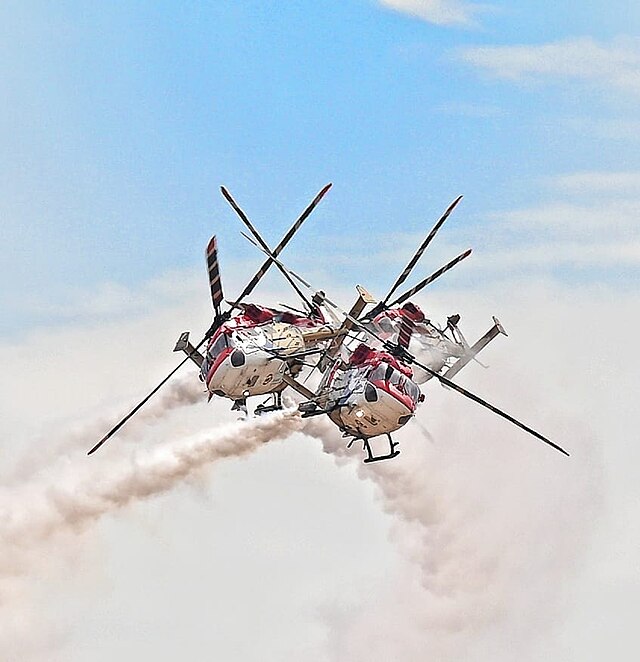
EGYPT INTERNATIONAL AIRSHOW: SEPTEMBER 2024

In the global airpower arena, advancements in aerospace power are frequent, swift and multi-dimensional. Airpower proves to be a critical facet in the race for global/regional dominance and as a credible deterrent. It therefore pays for countries to keep abreast with the latest trends in aerospace technology, in order to identify cutting-edge assets, which would in turn influence development/procurement roadmaps of respective Nations.

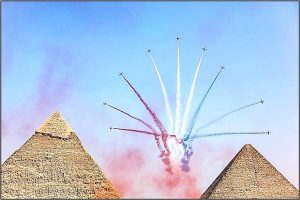
Source- english.ahram.org.eg
The first edition of the Egypt International Airshow (EIAS), spotlighted in this article, was held from 03-05 September 2024 at Egypt’s El Alamein International Airport, 160 Km West of the historical city of Alexandria. The event was inaugurated by the President of Egypt, and aims to accelerate industrialisation and digitalisation in Defence, Space, and Commercial Aviation sectors in Africa and the Middle East.
Over 300 companies/entities, representing more than 100 countries participated from the global aviation/aerospace industry, making the event the largest of its kind in Africa and the Middle East. Additionally, the Arab Organization for Industrialization (AOI) and China’s National Aero-Technology Import and Export Corporation (CATIC) were organizations that participated in the event.
Technology Demonstrated at EIAS 2024
The EIAS commenced with a performance by the Egyptian Air Force aerobatic team, the Silver Stars, followed by a solo aerobatic display by Dassault Aviation’s Rafale Multi-Role Combat Aircraft, China’s Y-20 Heavy Lift Transport Aircraft (HLTA), Saudi Arabia’s Eurofighter Typhoon, and aerobatic displays from Air Forces of the United States (US), France, Italy, the Czech Republic, United Arab Emirates, Türkiye, and the Indian Air Force’s (IAF) Sarang Helicopter Display Team (HDT). The event also hosted a static display, exhibiting military/civil aircraft and unmanned aerial vehicle (UAV) models. The platform also witnessed important agreements inked between African/Middle-East Nations and global aerospace firms.

Static Display at EIAS-24:Source-dailynewsegypt.com
Sarang Aerobatic Display. The Sarang HDT, renowned for its precision aerobatics manoeuvres, features the Hindustan Aeronautics Limited (HAL) multi-role, multi-mission Dhruv Advanced Light Helicopter ( ALH Mark-I), first inducted into the Indian Armed Forces in 2002. The HDT, comprising five Dhruv ALH, was airlifted to Egypt in a C-17 Globemaster Strategic Lift Aircraft, also on the inventory of the IAF (read more about the Dhruv ALH program in an earlier article @ https://chanakyaforum.com/an-indian-helicopter-story/ ).
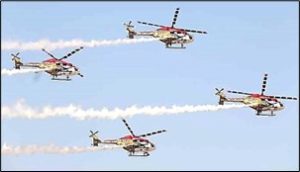
Sarang HDT Aerobatic Display at EIAS 2024:Source-jetlinemarvel.net
Indian Pavilion
India’s display pavilion showcased BDL’s ASTRA Mark-1 Air-to-Air Missile (AAM) (read more @ https://chanakyaforum.com/iafs-vajrayudha-the-astra-air-to-air-missile/ ), DRDO’s and associated lab’s AKASH Surface-to-Air Missile (SAM) (read more @ https://chanakyaforum.com/akash-boosting-indias-ground-based-interception/ ) and scaled model of HAL’s TEJAS Light Combat Aircraft (read more @ https://chanakyaforum.com/lca-tejas-ready-to-touch-the-skies-with-glory/).
Helicopters
Turkish Aerospace Industries (TAI) displayed the T129 ATAK helicopter, jointly developed by TAI and Agusta Westland, presently the helicopter division of the Italian Defence and Aerospace firm Leonardo. The T129 is a twin-engine, tandem-seat, multi-role, all-weather attack helicopter based on the Agusta A129 Mangusta platform. The ATAK program was conceptualised to meet the requirements of the Turkish Armed Forces for an armed tactical reconnaissance and attack helicopter. The T129, featuring a digital cockpit, is equipped with an advanced avionics suite, an automatic flight control system, an inertial navigation system, and a digital moving map display. A full-authority digital engine control system reduces the work load of the pilot by executing autopilot operations. It has a combat range of 561 Km, endurance of 3 hours, service ceiling of 20,000 feet and maximum-all-up-weight (MAUW) of 5 Tons. The helicopter has four hard-points which can accommodate 300kg each of payload. It is fitted with a 20mm three-barrel Gatling-type cannon. The T129 also has 12.7mm gun pods, Anti-Tank Guided Missiles (ATGM) and Air-To-Air Missiles (AAM), 70mm rockets and guided rockets. The more modern T129 is inferior to Boeing’s Apache AH-64 Attack Helicopter (also displayed) in terms of speed and MAUW, but is superior in terms of combat range. The T129 also has a much smaller silhouette than the AH-64, with a lower cost per unit. Boeing also showcased its CH-47F Chinook Advanced Multi-Mission Helicopter at EIAS-24, a variant of which is in service with India.

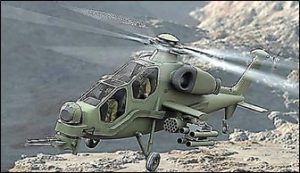
T129 ATAK:Source-Wikipedia/airforce-technology.com
Fighter Aircraft
Chinese J-10. The Chengdu J-10 Vigorous Dragon (NATO reporting name:Firebird), is a medium-weight, 4.5 generation, single-engine, multirole combat aircraft with a delta-wing and canard design. The J-10 is mainly designed for air-to-air combat, but can also perform strike missions. The J-10C, an upgraded version, is equipped with an Active Electronically Scanned Array (AESA) Fire-Control Radar, Imaging Infrared Seeker (IIR), and various PL-15 Air-To-Air Missiles. The J-10CE export version was purchased by Pakistan and officially inducted into the PAF’s No. 15 Squadron- on March 11,2022. The aircraft has a top speed of Mach 1.8, a combat range of 1240 Km and a service ceiling of 59,000 feet. The J-10C is perhaps the only non-Russian fighter in the world which can match the Su-30MKI in manoeuvrability, with both using thrust-vectoring engines, although the lighter Chinese jet has a higher thrust/weight ratio with its airframe extensively using light composite materials. The J-10’s altitude ceiling is the highest in the world for an operational single-engine fighter, albeit slightly lower than the Su-30MKI. The aircraft is presently in service with the PLAAF, Pakistan Air Force and Egyptian Air Force.
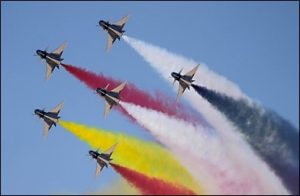

Chinese J-10 Fighter Jets Aerobatic/Static Display at EIAS 2024:Source-voanews.com/chinaview.cn
Hurjet Light Attack Aircraft/Kaan Air Superiority Fighter (ASF)
TAI’s Hurjet Light Attack Aircraft, flew on the first day of EIAS-24 (read more @ https://chanakyaforum.com/the-farnborough-air-show-2022-prospects-for-india/ ). In addition to the Hurjet, TAI displayed its indigenous combat aircraft Kaan, formerly known as the Turkish Fighter (TF-X). The Kaan is a Fifth-Generation, stealthy, twin-engine, all-weather ASF in development by TAI and BAE Systems, first shown as a full-scale mock-up at Singapore Airshow 2022. The jet is envisaged to replace the Turkish Air Force’s F-16 aircraft and for export. The maiden flight of the prototype was successfully completed on February 21,2024. In 2015, the TAI released three potential airframe configurations, resembling the Lockheed Martin F-22, General Dynamics F-16 and the Saab JAS-39 Gripen. TAI has stated that all three conceptual designs thus far feature a design optimized for low radar cross-section, internal weapons bays, and the ability to supercruise- features associated with fifth-generation fighter jets. TAI’s Advanced Carbon Composites fuselage (ACCF) facility, which was commissioned to produce fuselages for Lockheed Martin’s Joint Strike Fighter F-35 program, has been tasked with developing an ACCF for the TF-X. The Kaan will be capable of Manned-Unmanned Teaming (MUMT) (read more @ https://chanakyaforum.com/the-unmanned-wingman/). Presently, prototypes and the first batch of service aircraft will be equipped with General Electric F110 afterburning turbofan engines, each providing a thrust in excess of 125 KN, until the TAEC engine, a joint venture between the Turkish KALE & British Rolls-Royce, is completed and ready. The aircraft is envisaged to have a top speed of Mach 1.8 and a service ceiling of 55,000 feet. The Kaan will mount Turkish and MBDA Beyond Visual Range AAMs, Air-to-Surface Missiles and Anti-Ship Missiles, in addition to LASER-Guided Bombs.
Boeing’s F-15 EX (an erstwhile contender for India’s Multi-Role Fighter Aircraft Program), and their T-7A Advanced Jet Trainer (AJT) was also showcased.

TAI’s Hurjet:Source-citd.eu
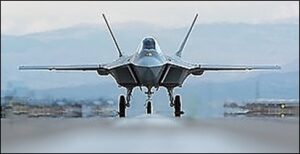
Kaan During Taxi Trials at Ankara Air Base: Source-Wikipedia
Transport Aircraft/Tankers
Y-20 HLTA. China’s Y-20 Kunpeng HLTA (named after a mythical bird) was displayed outside China for the first time at EIAS-24. The Y-20 has been developed by the Xi’an Aircraft Industrial Corporation. It is powered by four Shenyang WS-20 turbofan engines, each generating 140 kN (31,000 lbs) of thrust. It has a cargo capacity of 66 tons, which could include two light tanks, or one 58 ton Main Battle Tank, or combat troops in excess of 125 personnel. It has a ferry range of 10,000 Km (7800 Km with full cargo load) and a service ceiling of 43,000 feet. This gives it global reach for cargo transportation/airborne operations. The strategic lift aircraft was first handed over to the PLAAF in 2016. It is also manufactured in the aerial tanker and Airborne Early Warning & Control (AEW&C) variants. The Y-20 is the first transport aircraft that utilizes 3D printing technology for certain components to expedite aircraft development and decrease manufacturing costs! Notably, one Regiment of the aircraft each is in service with the PLAAF’s 4th and 13th Transport Division, located in China’s Western and Southern Theatre Commands, located alongside India. The Y-20 is larger than Russia’ Ilyushin-76 Transport Aircraft, and has a payload capacity less than the US C-17 Globemaster. However, it is the only strategic lift transport aircraft that is presently in production globally, with a present annual turn out of six aircraft per year, upgradable to 14 by the 2030s!
Boeing also showcased its KC-46 Pegasus Transport Aircraft and Aerial Refueller ( read more @ https://chanakyaforum.com/the-singapore-air-show-2022-opportunities-for-the-indian-armed-forces/ ).
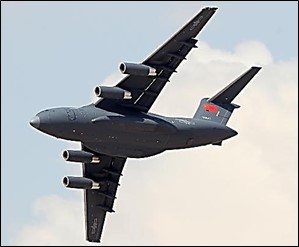

Flight Demonstration of China’s AY-20 Large Military Transport Aircraft:Source- chinaview.cn
UAVs/Counter-UAS Systems
The Egyptian-made EJune 30, Ahmous, and October 6 Medium-Altitude-Long-Endurance (MALE) UAVs were displayed. The latter is a combat UAV (UCAV) and can be armed with guided missiles and aerial bombs. TAI’s Aksungur UCAV, with a range of 6500 Km, endurance of 60 hours and a total hardpoint capacity of 1900 Kg, was also displayed. Boeing displayed the InSitu ScanEagle MALE ISR UAV, with an endurance of 18 hours, ceiling of 19,500 feet and a dual-sensor, day-night ISR payload of Electro-optical and Medium Wave Infra-Red (MWIR) sensors and Visual Detection and Ranging (ViDAR) for maritime surveillance. Russia’s Defence equipment manufacturer, Rosoboronexport, showcased the Orlan-10E and Orlan-30 UAVs, being used extensively in Ukraine (read about the Orlan @ https://chanakyaforum.com/drones-in-the-russia-ukraine-war/) and RB-504P-E Drone Countermeasures System (DCS). This DCS is designed for automatic search, detection, direction finding and neutralisation of UAVs up to at least 1.8 Km range by radio-electronic interference over the control/data transmission channels of UAVs and also their SATNAV on-board receivers.

Aksungur UCAV:Source-militaryleak.com

InSitu ScanEagle MALE UAV:Source-insitu.com

RB-504P-E DCS:Source-recomonkey.com
Missiles
Apart from India’s ASTRA and AKASH mentioned above, Rosoboronexport featured the Viking and Tor-M2E SAM Systems (read more @ https://chanakyaforum.com/military-contours-of-the-russo-ukraine-war/ ), as well as the subsonic Kh-69 Air-Launched Stealth Cruise Missile (ALCM). The latter has a range of 400 Km, uses satellite/inertial guidance and is capable of flying at extremely low altitudes to avoid radar detection. It can be launched from the Sukhoi and MiG series of fighter aircraft and is rumoured to have been used in the Russia-Ukraine war.
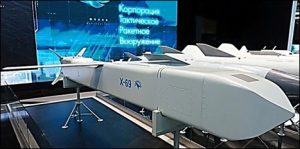
Kh-69 ALCM:Source-en.defence-ua.com
On the sidelines of EIAS-24, Egypt’s Ministry of Military Production showcased the ST100/ST500, manufactured for the Egyptian military. The ST-100 is a multi-mission/multi-role, mine-resistant, ambush-protected (MRAP) armoured troop carrier, capable of carrying 8-10 personnel, with an operational range of 700 Km and top speed of 115 Kmph. The ST100 can be armed with 7.62×51mm/12.7×99mm machine guns/40 mm grenade launcher, which can be installed on a remote-controlled weapon station. The ST100’s active-defence system includes sensors for detection/warning against laser designators, ATGMs, and thermal/electro-optical jamming attempts. The system also includes smoke-screen launchers and aerosol dispensers, to obscure an adversary’s electro-optical/thermal/LASER/radar-guidance capabilities. The ST100 is operated by Egypt, Saudi Arabia and the UAE. The ST500 is a smaller tactical vehicle for troop transport/special forces operations, and ambulance duties. It has a greater top speed of 140 Kmph and can also serve as a mortar-carrier/ATGM launcher. It is additionally in service with the Iraqi Armed Forces.

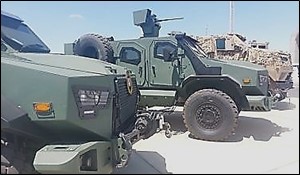
ST100 and ST500 at EIAS-24:Source-dailynewsegypt.com
Additionally, certain landmark agreements were inked at EIAS-24. The French Safran Group, a leading aircraft engine manufacturer, selected the Arab Organization for Industrialization (AOI) as the sole overhauler of engines for the Dassault/Dornier Alphajet Aircraft, an AJT/Light Attack Jet in service with 9 countries in Europe, Asia and the Middle East, including Egypt. The event also saw finalisation of a contract for manufacturing advanced defence systems between Arab British Dynamics, an AOI subsidiary, and China’s ELINC company, a wholly-owned subsidiary of China Electronics Corporation, specialising in defence electronics, industry solutions and cybersecurity.
Conclusion
EIAS-24 is a pointer towards the technology infusion into Africa and the Middle East. The predominant Russian and Chinese presence underscores their military ambitions and expanding footprint of military technology in these regions. This region represents investment opportunities for cutting-edge military technology which India must exploit to enhance its extra-regional influence.
Disclaimer
The opinions expressed in this article are the author’s own and do not reflect the views of Chanakya Forum. All information provided in this article including timeliness, completeness, accuracy, suitability or validity of information referenced therein, is the sole responsibility of the author. www.chanakyaforum.com does not assume any responsibility for the same.
Chanakya Forum is now on . Click here to join our channel (@ChanakyaForum) and stay updated with the latest headlines and articles.
Important
We work round the clock to bring you the finest articles and updates from around the world. There is a team that works tirelessly to ensure that you have a seamless reading experience. But all this costs money. Please support us so that we keep doing what we do best. Happy Reading
Support Us





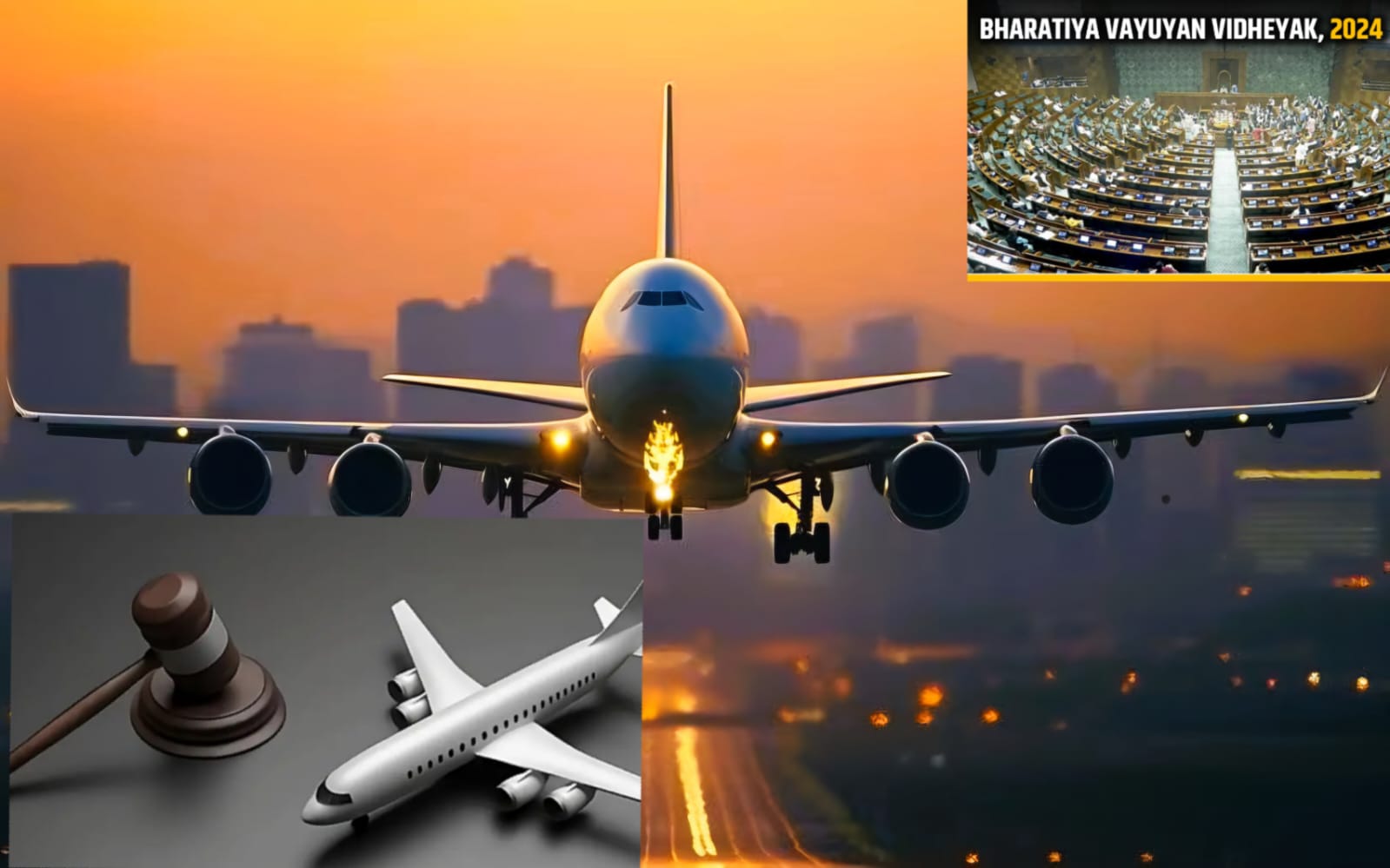
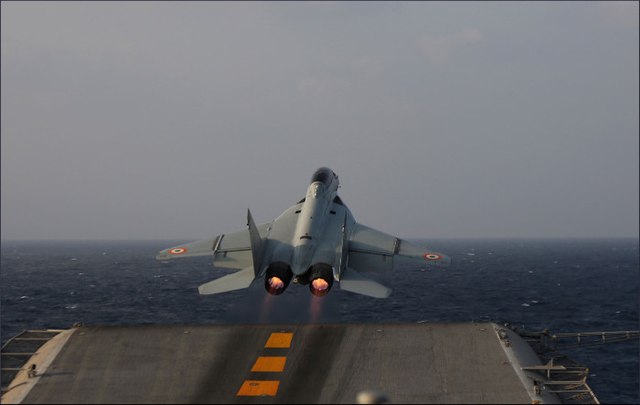


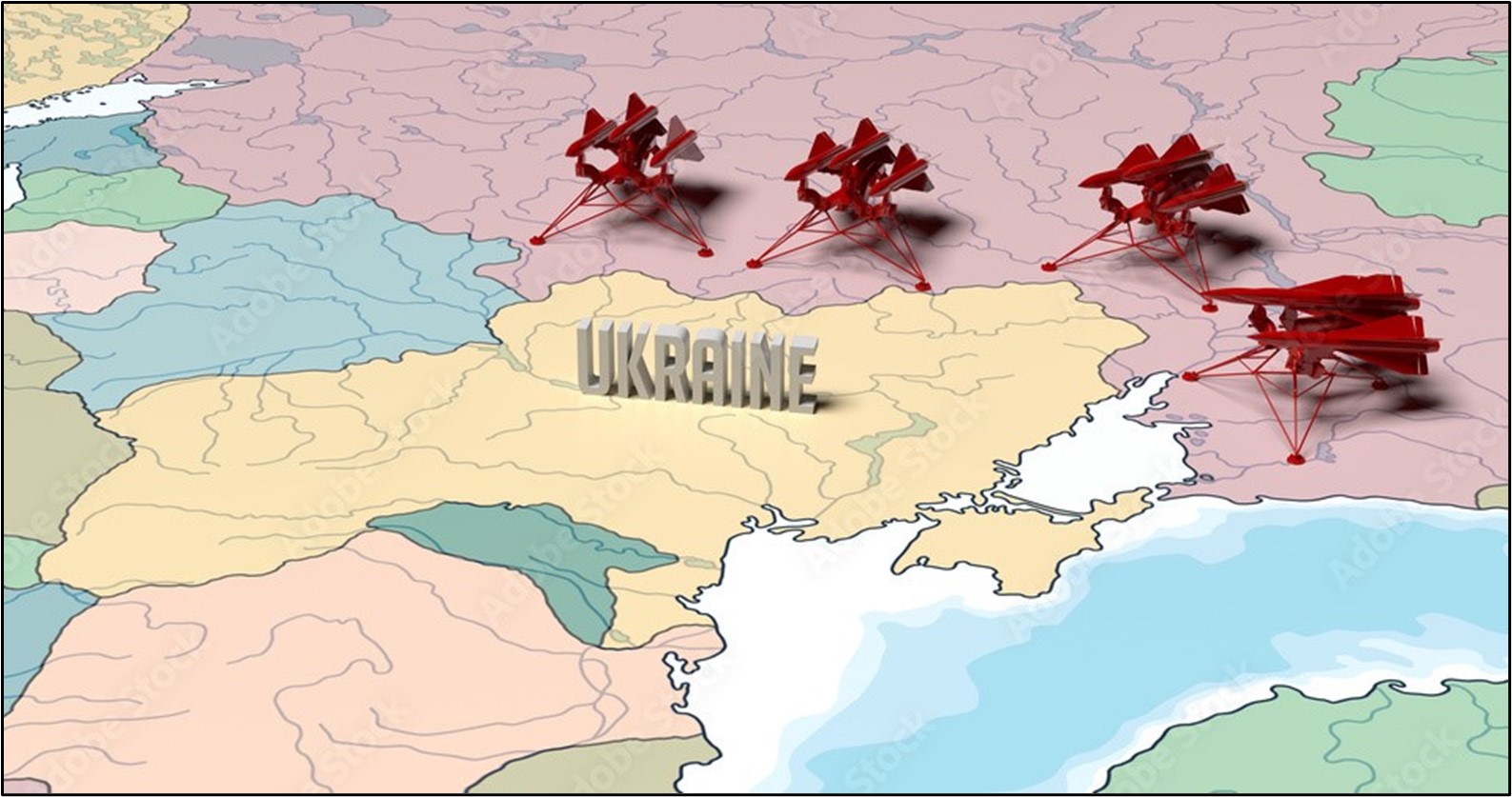

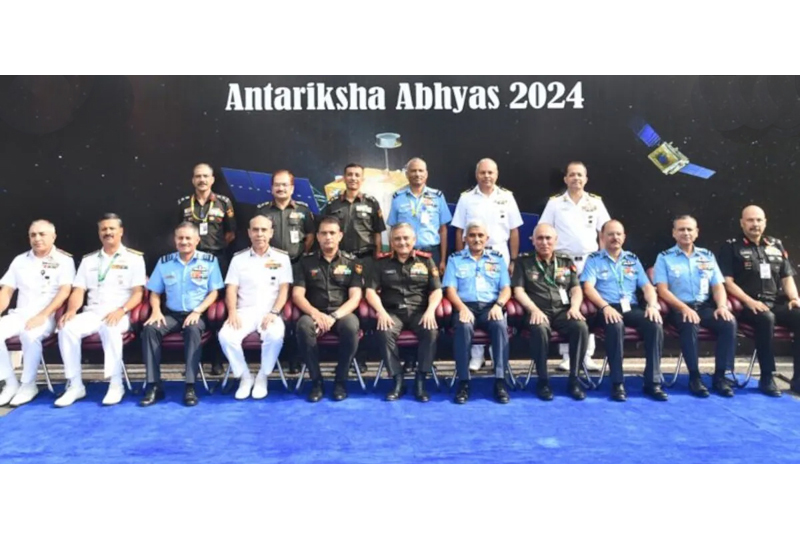









POST COMMENTS (0)